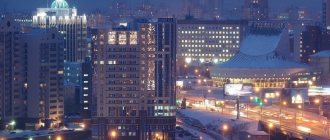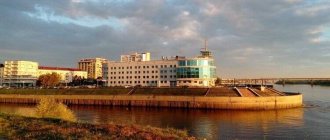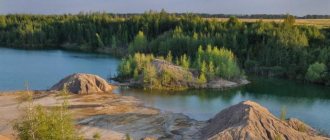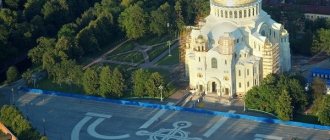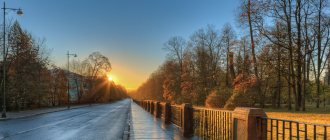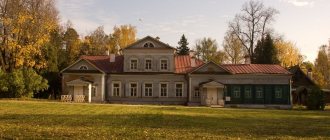Tour guide Ksenia Vasilyeva told the Kultura.RF portal how tourists can spend their time in Tomsk in an interesting and informative way. Visit a natural open-air geological museum, visit the “Siberian Athens” and look into the catacombs of the Tatar settlement.
I was born and raised in Novosibirsk. She moved to Tomsk when she entered the Faculty of Law at Tomsk State University. I successfully completed it, but realized that it was not for me. Since childhood, I dreamed of becoming an actress, and here I also wanted something creative. I came across a vacancy at the Tomsk History Museum. And they accepted me - even without experience in this field. I began leading tours in the museum, and then around the city. I was imbued with the history of Tomsk. An opportunity arose to combine my profession with my hobbies - I began conducting theatrical excursions. Some may think that being a guide, and especially in a museum, is monotonous and dreary. But for me this is a multifaceted job with enormous creative potential, in which there is always freedom of expression.
Top tips for tourists
Photo provided by the winner of the “Best Guide of Russia” competition, Ksenia Vasilyeva
Photo provided by the winner of the “Best Guide of Russia” competition, Ksenia Vasilyeva
Photo provided by the winner of the “Best Guide of Russia” competition, Ksenia Vasilyeva
First - don’t be afraid to come to Tomsk! Most often, people come to our city involuntarily: some on a business trip, some passing through - and do not assume that we have anything worthwhile. Once upon a time I came here from Novosibirsk, which is almost twice as large, but the small provincial town captivated me with its comfort and hospitality.
Second tip: try to see Tomsk in winter. Especially on New Year's Eve, especially if there is no New Year's mood. Heavy snow turns the city into a winter wonderland.
Third: walk more, because all the attractions are nearby. And to get to know the city, the easiest way is to take a guide as your companion. If this is not possible, wander around the website of our Tourist Information Center and trust my route - we will discover Tomsk together.
Talovsky bowls
Address : Tomsk region, village. Talovka How to get there: to the village of Basandaika, 40 km southeast of Tomsk.
The Talovskie bowls are an interesting geological monument. They are large limestone bowls filled with water, and the village located nearby gives them their name. The original travertine shape was carved by underground waters saturated with lime and birnessite.
It is important to note that the Tomsk region is the second place where this geological material exists; their formation occurred during the Paleozoic period. Their diameter is about 1 m, and the length of the largest bowl reaches 3.5 m. The water from these bowls is always at a constant temperature of +6˚ and is healing, relieving eye diseases and diseases of the gastrointestinal tract.
There is an assumption that it was they who served as the prototype of the holy grail. The Visigoths, moving from east to west, preserved the memory of the healing powers of water from the bowls and then wove them into the legends of Arthur.
If you have not yet chosen where you will live and want to save money when booking, we recommend using the RoomGuru service. Firstly, it contains hotels, apartments and guest houses from many different booking systems, so you won’t miss out on a worthwhile option. Secondly, you can immediately compare prices for one place in different services and book where it is cheaper (this is not always Booking!).
Start with the Camp Garden
Landscape of the Tom River from the Camp Garden. Tomsk Photo: Alexey D. / photobank “Lori”
Camp garden. Tomsk Photo: Artem Izofatov / tomsk.ru
Memorial to the military and labor glory of Tomsk citizens in the Camp Garden. Tomsk Photo: chemodanus.ru
If you come to Tomsk from the west, from the Shegarsky tract, then you just need to cross the Communal Bridge, and you are immediately in the city center. The Camp Garden begins along Nakhimov Street. This is a natural open-air geological museum with dozens of different rocks. The garden is not called “camp” because of concentration camps or prisons. Here in the 18th century, summer camps of the Tomsk Infantry Regiment were located, and in the 19th century, townspeople began to walk there. During archaeological excavations in 1895, a site of an ancient man with mammoth bones was found there. And in the 20th century, after the Great Patriotic War, a Memorial to the Military and Labor Glory of Tomsk Residents was installed in the park.
From the wooded hills of the Camp Garden there is a stunning view of the opposite bank of the Tom River - it begins in Khakassia, flows through the Kemerovo region, and in our region flows into the Ob. Along the cascades of the embankment you can get to the water itself, and along the way you can feed the squirrels: there are a lot of them here.
Let's sum it up
Tomsk is a beautiful city with many original monuments, unique wooden buildings, museums and temples. To fully explore its attractions, you will need to spend more than one month in Western Siberia; For a brief overview, it will be enough to visit the fifteen objects listed above. At the end of your trip around Tomsk, you can see interesting places in Novosibirsk - there are also a lot of them.
Like the sights of Belgorod, the carvings, parks and memorials of Tomsk are a must-see for anyone interested in the history of Russia. Planning your trip will not take too much time; Just take the necessary documents and money with you and hit the road. You can get to Tomsk either by train or by plane; in the latter case, it is important to clarify in advance when check-in for the flight begins and ends.
Capture the student spirit
"Stone Women" in the University Grove. Tomsk Photo: chemodanus.ru
The main building of Tomsk State University. Tomsk Photo: Mikhail Markovsky / photobank “Lori”
Monument “To Professors Vasily Florinsky and Dmitry Mendeleev from grateful Siberians” in the University Grove. Tomsk Photo: tic-tomsk.ru
Nakhimov Street is crossed by Lenin Avenue, one of the main arteries of Tomsk. It starts with four consecutive universities. Tomsk is called the “Siberian Athens”: in 1888, the first university in Siberia opened here and science began to develop. And since then, Tomsk has become a city of students, which is felt especially acutely in late spring and early summer, during the summer session.
On the left side you will see the buildings of the Polytechnic University, which has existed since 1896. Soon the University Grove will open - with tombstones-portraits of ancient Turkic leaders (“stone women”) and the grave of Porfiry Krylov, who founded the Siberian Botanical Garden and laid out the grove itself. Don't miss the innovative monument to Vasily Florinsky and Dmitry Mendeleev: using the TSUniverse application you can see a 3D model of the Tomsk State University campus at the beginning of the 20th century. This is the first university in Asian Russia, its main building is visible behind the grove.
Go out again to Lenin Avenue, there you will find the main building of Siberian State Medical University, the former Tomsk Medical Institute. And opposite the building of the University of Control Systems and Radioelectronics, on Novo-Cathedral Square, you can take classic photos - next to the “I Love Tomsk” stele.
Memorial to the Creators of Space Technology
The contribution of Tomsk scientists to the creation of rocket technology used for defense and space flights is invaluable. The research and production association "Polyus" achieved particular success - and it was in front of it that, in the year of the enterprise's sixtieth anniversary, a memorial to the Creators of space technology was erected.
Memorial to the Creators of Space Technology
The monument consists of three semantic parts: a copy of the Proton launch vehicle 12.8 meters high, two symbolic satellites with orbits and a monument to Pyotr Vasilyevich Golubev, the founder of the NPO Polyus. The memorial was erected in 2011; after a small restoration in 2016, it looks great again - tourists often take pictures next to it, and students and workers of the research and production association relax on benches nearby.
The location of the monument is Kirov Square, one of the busiest points in Tomsk. After visiting the sights, you can take a walk here, have a snack before a further tour of the city, or immediately head further - towards the oldest Siberian university. In summer, it is highly recommended to take a walk: along the way, the tourist will meet several wooden houses with openwork carvings - the real pride of Tomsk; In winter, you should use a bus, trolleybus or take a taxi - you will have to pay about 100 rubles for moving from place to place.
Memorial to the Creators of Space Technology - how to get there and how much the excursion costs:
- address: Kirov Square (stop “Kyiv”);
- travel: by bus, taxi or car;
- time for visit: around the clock;
- cost: free.
Take a look at the catacombs of the Tatarskaya Sloboda
Red Cathedral Mosque. Tomsk Photo: tripadvisor.ru
Center of Tatar Culture. Tomsk Photo: tatar-tomsk.ru
White Cathedral Mosque. Tomsk Photo: islamio.ru
Turn onto the Moskovsky tract and find Tatarskaya Street, this is the center of the former Tatarskaya Sloboda. It preserves many wooden buildings from the 19th and early 20th centuries: a whole area of ancient architecture.
Tatars are the original population of Tomsk lands. According to legend, the local river got its name from the Tatar girl Tom. She and her beloved Ushay threw themselves into the water because their parents did not allow them to be together. It was the Tatars who turned to Boris Godunov in 1604 with a request to build a fort for protection against nomads - the Yenisei Kyrgyz and Kalmyks. This is how Tomsk appeared. And the Tatars traded and were engaged in crafts here; the White and Red Mosques and special schools and madrassas became the spiritual centers of the settlement.
Today the main custodian of Tatar antiquity is the Center of Tatar Culture. It is located on nearby Gorky Street in the mansion of merchant Karim Khamitov. Be sure to look into it, you will be treated to chak-chak and “crow porridge”, and perhaps even taken to the dungeon. Previously, there was a whole system of tunnels near Tomsk. Somewhere entrances or exits have been preserved, and under the Tatarskaya Sloboda there are entire paths. According to various versions, local merchants hid treasures there and set traps for their ill-wishers or uninvited guests.
The merchant Karim-bai also had his own underground passages. It was believed that the underground canals he laid led to the river and even passed under it: supposedly this is how the merchant led his herds to the water meadows. Like many Tatars, Karim-bai bred thoroughbred horses and was engaged in carriage - the Moscow Highway passed nearby, which opened the way to Asia and mainly to China. The coat of arms of Tomsk today depicts a silver horse.
Belinsky Street
Belinsky Street as a whole attracts attention with one outstanding building - the house of the architect Khomich (no. 19). It rises like a fairy-tale tower among other buildings. Its cost at the time of construction in 1910 was about 50,000 rubles. The annual salary of the engineer who built it was 1800 rubles.
S. V. Khomich studied for 6 years at the Engineering Institute in St. Petersburg. His file contains many certificates of health problems; but in 1891 he was given a job as a junior engineer at the provincial council of Tomsk. His career was rapid and in a few years, having changed many positions, Khomich became a very popular and sought-after architect in the city.
The building stands on land that was given as a dowry to his wife Olga. The house turned out to be so huge for a family of three that part of it began to be rented out. In 1914, S.V. Khomich was accused of embezzlement and issuing false documents, after which he was forced to resign and leave. And the house still pleases the eyes of local residents.
Look at Anton Chekhov “through the eyes of a drunken man”
Monument “Anton Pavlovich in Tomsk through the eyes of a drunken man lying in a ditch and not reading Kashtanka.” Tomsk Photo: russights.ru
Embankment of the Tom River. Tomsk Photo: znaigorod.ru
Monument to revolutionary Joseph Kononov in Theater Square. Tomsk Photo: tripadvisor.ru
After passing Tatarskaya, turn onto Aleksey Belents Street - and you will again find yourself on Lenin Avenue. On the way you will notice Theater Square and in the distance the Theater for Young Spectators. Move to the embankment, there you will see how the legendary lovers were reunited: at the monument to “Sincere and Pure Love” the Ushaika River flows into the Tom.
And behind the turn to the left there is a sculpture “Anton Pavlovich in Tomsk through the eyes of a drunk man lying in a ditch and who has not read Kashtanka.” Chekhov was in Tomsk in 1890 on his way to Sakhalin Island. Here he lost his galoshes and caught a cold. And he didn’t like the city so much that he even wrote down: “Tomsk is not worth a penny... The most boring city... and the people here are the most boring... The city is drunk... The dirt is inexorable... at the inn the maid, handing me a spoon, wiped it on her butt... The dinners here are excellent , unlike women, who are hard to the touch...” The only thing that pleased him was the lunches at the Slavic Bazaar restaurant right next to the monument. And so many years later, in 2004, the sculptor Leonty Usov “revenged” Chekhov for all the Tomsk residents: he sculpted the writer in an absurd hat, lopsided glasses, barefoot and with big feet.
Resurrection Church
The entire upward-facing stone temple was built more than two hundred years ago on the site of a burnt wooden church. The style of construction is the so-called “Siberian Baroque”, which is practically not preserved in Western Siberia and is not found in Eastern Siberia.
Resurrection Church
After 1937, the Church of the Resurrection was closed, but remained intact; the only damage was the removed bell and the demolished fence. Divine services were resumed here in the 1980s, and in 2004 a new bell was installed on the bell tower, repeating the previous one in the smallest detail. The church is open to visitors every day from early morning until evening; here the tourist can once again be convinced of the splendor of the ancient, elegant and always lovely Tomsk.
Resurrection Church - how to get there and how much the excursion costs:
- address: Oktyabrsky Vvoz street, 10 (stop “TGASU”);
- travel: by bus, taxi or car;
- visiting hours: daily from 07:30 to 18:30;
- cost: free.
Find out where Bakunin got married and Radishchev lived
Monument to Vladimir Lenin and the chapel of the Iveron Icon of the Mother of God. Tomsk Photo: temples.ru
Museum of the History of Tomsk. Tomsk Photo: Olga S. / photobank “Lori”
Resurrection Church. Tomsk Photo: Natalia Makarova / photobank “Lori”
Walk along the embankment a little until you see a flagpole and a monument in honor of the 400th anniversary of Tomsk on your right hand. You will find yourself on Lenin Square - the oldest and main one in Tomsk. It was here that the Cossack pioneers camped before the emergence of the fort, and later the Market Square, the busiest and liveliest place in the city, was located. Move straight until you see the monument to the leader and the chapel of the Iveron Icon of the Mother of God, which was built according to the model in Moscow.
A little further behind it on your left you will see a turn. This paved street, Bakunina, is the first and oldest in the city. The ascent to Resurrection Mountain begins from there. On the right hand is the Tomsk History Museum, where I work. The wooden extension on the roof of the museum used to be a fire tower: firefighters were on duty there around the clock. And now here is the highest observation deck in the city. To the right of the museum you can see the Tomsk Fortress with the Spasskaya Tower. This is a reconstructed part of the fortifications that were erected here at the beginning of the 17th century. It is here that the world's largest wooden ruble is now stored - a monument exactly 100 times larger than the original.
Both our compatriots and foreigners were sent into exile in Tomsk. So Poles, Lithuanians, Germans, and Swedes settled here. In 1833, the Catholic Church of the Intercession of the Blessed Virgin Mary was built in the city; you will find it on the left side as you go up the street. There a meeting took place between the exiled revolutionary Mikhail Bakunin and the Polish woman Antonina Kwiatkowska. And they got married in 1858 in the Church of the Resurrection - you can see it on Oktyabrsky Vzvoz Street. The Resurrection Church was cut down in 1622, which is why the hill on which it is located began to be called Resurrection Mountain. In 1789–1807, the temple was rebuilt in stone - in the famous “Siberian Baroque” style.
In 1791, exile Alexander Radishchev arrived in Tomsk, and was sheltered by the city commandant, Thomas de Villeneuve. His house is located opposite the church. It was there that Radishchev and Villeneuve committed a “daring” trick: to annoy Catherine II, they launched the first hot air balloon in Siberia - a hot air balloon.
Museums and theaters of the city of Tomsk
Tourists who prefer educational leisure and an extensive cultural program will have plenty to visit in Tomsk. The city will delight you with an abundance of theaters and, especially, museums.
Mineral Museum
- Working hours: Monday-Friday, from 10:00 to 17:00.
- Ticket price: 100 rub.
- Telephone.
- Website: https://www.ggf.tsu.ru.
- Address: Lenin Avenue, 36. TSU building, room. 142. Transport stop "University".
An extremely educational and exciting excursion is offered to visitors of the museum. I.K. Bazhenov, organized back in 1888 at the local university. Behind the display cases of stands here you can see more than 700 varieties of minerals collected by expeditions in Altai, the Urals, Kuznetsk Alatau, the Sayan Mountains, Transbaikalia and Mongolia. In total, the collection includes more than 50 thousand samples of various rocks, semi-precious and precious stones. An experienced guide will tell you a lot of interesting things about the secrets of the mineral kingdom.
Beer Museum
- Working hours: Monday-Friday, from 9:00 to 18:00.
- Ticket price: 120 rub.
- Phone: +7-913-829-78-49.
- Website: https://www.tomskbeer.ru.
- Address: Moskovsky tract, 46. Transport stop "Pivzavod".
Fans of the foamy drink in Siberia appreciate the products of Tomskoe Beer OJSC for their rich taste and impeccable quality. In 2004, an original museum was opened at the plant. Its exhibitions tell about the history of the enterprise, the traditions of the art of brewing from ancient times to the present day.
Visitors will be able to see an extensive collection of beer mugs, labels, coasters and other accessories. Among the exhibits there are real rarities of the 18th century. The excursion includes a visit to the plant's workshops and tasting of beer and non-alcoholic products of the plant.
Tomsk Local Lore Museum
- Address: ave. Lenina, 75.
One of the main museums not only in the city, but throughout the entire Tomsk region, is dedicated to the history and culture of the region. The main museum building is located in a historical building - an estate of the 19th century. This house once belonged to a local businessman named Astashev, who was engaged in gold mining. The museum's richest collection numbers more than 140 thousand items.
The museum presents exhibitions about the lives of famous townspeople, about local nature - the flora and fauna of the region. Two halls are occupied by the “prehistoric era” - the exhibition talks about “stones”, the geology of the Paleolithic and Neolithic. One of the exhibitions bears the “musical” name “Heavy Metal,” but it is dedicated not to the direction of heavy music, but to the material. It contains various metal objects.
See: Sights of the Tomsk region
Museum of Tomsk History
- Address: st. Bakunina, 3.
Along with the local history museum, there is also a historical museum in Tomsk. It appeared relatively recently - in 2003, but its exhibition will allow you to take a fascinating excursion into the past and learn about the life of Tomsk residents in different eras.
Visitors are invited to visit the Streltsy Tower, which defended the city several centuries ago, and see Tomsk from the height of the fire tower.
The museum presents exhibitions telling about the life of peasants and merchants, you can see a collection of famous local porcelain produced at the enterprise of the manufacturer Kuznetsov and many more interesting historical and archaeological exhibits.
The first museum of Slavic mythology
- Address: Zagornaya st., 12.
Mythology has always played an important role in the life of society. Great philosophers and scientists believed that the mythological view of the world preceded the “religious” and modern “scientific” ones. Tomsk has a unique, one-of-a-kind museum that immerses residents and guests of the city in ancient times, in the era of Slavic paganism.
The Museum of Slavic Mythology displays examples of painting and sculpture inspired by the beliefs of our ancestors. Once upon a time it was a small private gallery, opened on the basis of a specialized library. Its history dates back to 2005. Today it is a large exhibition and educational center of the city of Tomsk.
Drama Theater
- Opening hours: performances are given from Tuesday to Sunday inclusive, performances begin at 19:00 on weekdays, at 18:00 on weekends. On Sunday there are matinee performances for children.
- Ticket price: from 200 to 350 rubles.
- Telephone.
- Website: https://tomskdrama.ru.
- Address: Lenin Square, 4. Transport stop "Lenin Square".
Fans of performing arts simply need to visit the drama theater, founded back in 1850. First, it will amaze you with the grace of the architecture of the building, erected in 1978 according to the design of the architect G. I. Arrangereeva, and then with the splendor of the production and the excellent acting.
The theater's repertoire includes diverse performances of classical and modern plays. The troupe regularly participates in popular theater festivals, where it has received prizes more than once. The performances attract with the brightness of the scenery and costumes, and the stagecraft of the performers.
Theater "Skomorokh"
- Opening hours: performances are given from Wednesday to Sunday inclusive.
- Ticket price: 200-300 rub.
- Telephone.
- Website: https://www.skomoroh.tomsk.ru
- Address: Solyanaya Square, 4. Transport stop "TGASU".
If you are traveling with children, be sure to take them to this wonderful theater, whose history dates back to 1946. Nowadays it is located in a colorful historical mansion built in 1913, which is also of interest as an architectural monument.
The child will be delighted by the exciting performance with the participation of amazing puppets. Young theatergoers are greeted in the hall by cheerful buffoons who invite them to take part in exciting competitions and quizzes. The theater's repertoire includes 27 performances for children and 4 for adults.
Have tea at the House of Arts
Bakunin street. Tomsk Photo: Olga Voronetskaya / photobank “Lori”
Tomsk House of Arts. Tomsk Photo: 2do2go.ru
House No. 14 in the “Swamp” - the historical district of the city. Tomsk Photo: Dmitry Popovskiy / d-popovskiy.livejournal.com
Go downhill along Bakunina, turn left and walk along Obrub to Shishkova Street. There is the estate of the writer Vyacheslav Shishkov - now the Tomsk “House of Arts”. This is a modern cultural platform that hosts festivals, master classes and creative meetings with writers, artists, performers and musicians. Grab a cup of tea after viewing the exhibition and sit on the balcony. You will have a view of the area with the not very pleasant name “Swamp”. Of course, these are not the famous Vasyugan swamps in the Tomsk region, but the soil in these places is marshy. Therefore, there, practically in the center, only low-rise (no more than three floors) wooden buildings have been preserved.
Bakunina Street
The street became the very first pavement laid in Tomsk. Initially it was called Voskresenskaya, and until 1927 – Efremovskaya. One of the attractions is the church of 1833, designed by the architect of Tours. In the period from 1939 to the beginning of the 90s, the building was not a house of worship and was used for other purposes.
Near the church you can still find an ancient part of the wooden building, as well as a cobblestone street that has been preserved from the pre-revolutionary period.
Look at the “golden square” of wooden architecture
"House of Dragons" Tomsk Photo: zagran.guru
The Mother of God-Alexievsky Monastery, Kazan Cathedral and the Chapel of St. Theodore of Tomsk. Tomsk Photo: Andrey Nikolaev / photobank “Lori”
"House with Firebirds" Tomsk Photo: prvivl prvivl / fotokto.ru
Almost at the end of Shishkov, turn right - onto Lermontov Street. Cross the Ushaika River through the Aptekarsky Bridge and go up along Altaiskaya to Krasnoarmeyskaya Street. This is where your journey through the streets starting with the letter “K” and the “golden square” of wooden architecture of Tomsk of the late 19th - early 20th centuries will begin. Here you will find the “House with Dragons” and the estate of the merchant Leonty Zhelyabo - “House with Firebirds”.
Having reached Kirov Avenue, turn right and march towards the seventh house - the family mansion of the most famous architect in Siberia, Andrei Kryachkov. Today there is a Museum of Wooden Architecture with an impressive collection of “spare parts” of ancient houses: platbands, brackets, pediments, friezes.
Turn onto Kuznetsov. On this quiet street in a wooden house 20a, Lydia Delectorskaya, the future muse of the French artist Henri Matisse, was born and spent her childhood. Opposite you will see the elegant “House with a Spire”, and at the end of the street you will see the domes of the Mother of God-Alekseevsky Monastery, which dates back to 1605. Elder Fyodor Kuzmich is buried there. According to legend, he was Alexander I, who faked his death and became a wanderer.
Taste Siberian dishes in a former prison
Restaurant "Eternal Call". Tomsk Photo: yagurme.com
After several hours of walking around Tomsk, it’s easy to get hungry! Turn from Kuznetsov onto Herzen on the left, and at the Alexander Nevsky Church at the nearest intersection turn onto Sovetskaya. There is a restaurant called "Eternal Call". Since 1850, this building has been a correctional prison department, where people were imprisoned for minor crimes for short terms. And today here you can taste colorful local food: Siberian borscht with kulebyaka, elk cabbage soup with porcini mushrooms, dumplings, deer cutlets with minced pickled honey mushrooms, bear meat scraper and Ob sterlet on smoky coals. And don’t forget to find ice cream with pine nuts somewhere on the way home: this is a Tomsk delicacy.
Bonus
Monument to Happiness, or “Right now I’ll sing...”. Tomsk Photo: tic-tomsk.ru
If you have any strength left after a hearty dinner, take a taxi or take the “dvoika” trolleybus at the “Museum” stop on Frunze Avenue and go to Shevchenko Street. In the courtyard of residential buildings in Kursky Lane there is a monument to Happiness, or “Right now I’ll sing...”. This is a sculpted wolf from the cartoon “Once Upon a Time There Was a Dog.” Press the button on your stomach and you will hear one of his famous phrases. And then be sure to rub his belly - and you will be happy!
Interviewed by Tatyana Grigorieva
Peter and Paul Cathedral
The architectural style of the majestic temple is best described as pseudo-Russian; There are also modern Greek elements in it, which, however, do not interrupt the overall impression. The cathedral, built at the end of 1911 from the strongest red brick produced at a local factory and yellow sandstone, was requisitioned quite late after the October Revolution (only in 1938) - and seven years later it was returned to the Church.
Peter and Paul Cathedral
The main shrines of the cathedral in honor of the holy apostles Peter and Paul are a reliquary cross, soil from the tomb of the Apostle John the Theologian, ancient icons and a unique carved iconostasis. You can visit the temple at any time and completely free of charge; donations are welcome.
Peter and Paul Cathedral - how to get there and how much the excursion costs:
- address: Altayskaya street, 47 (stop “Tverskaya Street”);
- travel: by bus, taxi or car;
- visiting hours: daily from 07:30 to 19:30;
- cost: free.

